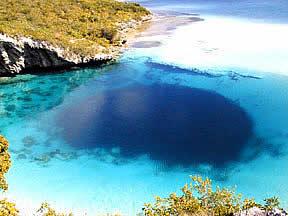Posted by: travadmin on May 08, 2003 – 06:22 PM
exoticlocations World’s deepest known sea cave provides spectacular plunge in the Bahamas
By Susan Cocking of The Miami Herald
LONG ISLAND, Bahamas – Stepping around a bluff onto a deserted beach on the south end of this island, I looked to my left and gasped. Before me was one of the world’s most spectacular natural wonders — and hardly anyone knows about it.
I was gazing at Dean’s Blue Hole, the world’s deepest known sea cave, which plunges 663 feet from its circular, midnight surface to the bottom. Partially surrounded by craggy limestone cliffs, the blue hole is so perfectly picturesque that it serves as a backdrop for Bahamas tourism brochures. Thousands have come to swim, snorkel, picnic, and scuba dive in the warm, clear waters over the years, but only one person, Jim King, has dived all the way to the bottom.
 All I wanted to do was dive part of the way. Jean Pierce, who’s opening a dive shop here with husband Kris Newman this summer, went with me last month. Anne Laurence, operator of the Chez Pierre Resort, opted to stay on the beach with her 3-year-old daughter, Alli.
All I wanted to do was dive part of the way. Jean Pierce, who’s opening a dive shop here with husband Kris Newman this summer, went with me last month. Anne Laurence, operator of the Chez Pierre Resort, opted to stay on the beach with her 3-year-old daughter, Alli.
”I think it’s scary,” Laurence, a non-diver, said.
Pierce and I weren’t exactly scared, but we acknowledged feeling butterflies as we set out our scuba gear on a tarp on the beach. We reassured each other that we would simply hop in, dive down no more than 100 feet and look around with our dive lights, staying out of any tunnels or passages and surfacing when our dive computers told us.
”How long do you think you’ll be?” Laurence asked us.
About 20 minutes, we told her, and resumed suiting up.
When we were ready, we only had to walk a few steps to the edge of the Blue Hole and drop in. The edge drops so steeply that a rivulet of white beach sand pours continuously into the hole. Pierce and I exchanged signals and sank beneath the surface.
Even with the trickling sand, visibility in the hole extended about 50 feet. We shined our lights on limestone ledges dotted with colorful sponges and soft coral. Squirrelfish, angelfish and snappers darted around us, playing hide-and-seek with our lights. As we continued our descent, we illuminated several narrow tunnels and caverns but did not enter them.
About 60 feet deep, I shined my light beneath a broad overhang and flashed on a silver, torpedo-like creature rising from the dark depths toward me. Instead of being frightened, I was intrigued: What was this weird, silver thing spiraling upward like a drill bit in reverse?
It turned out to be a three-foot barracuda swimming upside down. As it got close to me, it righted itself and grinned. I gave it a small salute and it swam away. I looked back down to the dark cave lip again and nearly grinned, too.
About a half-dozen tarpon, some as large as 50 pounds, emerged from the darkness. They milled around calmly, keeping their distance. Watching them, it occurred to me the only way to catch them on a fly rod would be to use sinking line. They never ventured close to the surface.
Pierce and I kicked slowly around the circumference of the blue hole, making a slow and deliberate ascent. When we broke the surface, I noted the relieved smile on Laurence’s face. Alli scampered around the beach collecting shells.
”How was it?” Laurence asked.
Pierce, an experienced divemaster, answered honestly: “You feel like something’s going to swallow you up. It’s more for high-adrenaline divers.”
I wondered if King felt that when he went all the way to the bottom in September 1992. I tracked down the 51-year-old retired entrepreneur from Sevierville, Tenn., while he was traveling in Arizona.
”What was it like? What did you see?” I demanded.
”Nothing,” King replied flatly. “I saw some angelfish in the shallows. But once you get in the dark zone, you don’t see anything — unless maybe it’s the lobster that ate Chicago!”
When I pressed for details, King said he breathed TriMix, a special mixture designed for deep diving, and descended about 60 feet a minute, taking 11 minutes to hit bottom. He remained there for only about three minutes, then began a very slow ascent. He spent nearly five hours decompressing.
”Well, the walls are pretty vertical,” he said. “It goes down about 300 feet and then it goes bell-shaped. I found a smooth, flat floor. There are a few tunnels. They are not very long and not very big.”
King said he first learned about Dean’s Blue Hole, named for the Bahamian family that owns the property, from geologist William Wilson. He said Wilson told him the blue hole probably is the result of a deep fissure or collapse beneath the ocean floor.
”Something very deep occurred — a geological fault, maybe. We don’t know what happened,” King said.
Wilson died last year, and King said he has given up cave diving. Now explorers have left the blue hole to the rest of us.